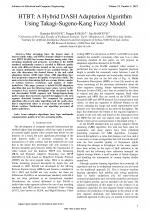| 1/2023 - 1 | View TOC | « Previous Article | Next Article » |
HTBT: A Hybrid DASH Adaptation Algorithm Using Takagi-Sugeno-Kang Fuzzy ModelBANOVIC, R. |
| Extra paper information in |
| Click to see author's profile in |
| Download PDF |
Author keywords
adaptive algorithms, fuzzy logic, multimedia communication, quality of service, streaming media
References keywords
streaming(18), adaptive(18), adaptation(14), video(12), rate(8), fuzzy(8), systems(7), networks(7), dash(7), quality(6)
Blue keywords are present in both the references section and the paper title.
About this article
Date of Publication: 2023-02-28
Volume 23, Issue 1, Year 2023, On page(s): 3 - 10
ISSN: 1582-7445, e-ISSN: 1844-7600
Digital Object Identifier: 10.4316/AECE.2023.01001
Web of Science Accession Number: 000937345700001
SCOPUS ID: 85150232251
Abstract
Video streaming takes the largest share of internet traffic today, and MPEG dynamic adaptive streaming over HTTP (DASH) has become dominant among other video streaming standards and protocols. According to the DASH standard, multimedia content is encoded in different quality levels with different bitrates located on the server, and users can request multimedia content of any available bitrate. The user side determines the desired bitrate in the unit called adaptation bitrate (ABR) logic. Many ABR algorithms have been proposed to improve the quality of experience (QoE). The main criteria for determining QoE are average bitrate, number of switches between resolutions, and number of buffer underflows. This paper presents a hybrid DASH adaptation algorithm that uses the following input values: current buffer occupancy level, network throughput value calculated on the last downloaded DASH segment, and Takagi-Sugeno-Kang model output that represents expected throughput in the next segment download iteration. We compared the proposed algorithm with several other algorithms and the results show that it outperforms others in average bitrate and number of bitrate switches. Furthermore, our algorithm prevented all buffer underflows. |
| References | | | Cited By |
Web of Science® Times Cited: 0
View record in Web of Science® [View]
View Related Records® [View]
Updated 3 days, 3 hours ago
SCOPUS® Times Cited: 0
View record in SCOPUS® [Free preview]
There are no citing papers in the CrossRef Cited-by Linking system.
Disclaimer: All information displayed above was retrieved by using remote connections to respective databases. For the best user experience, we update all data by using background processes, and use caches in order to reduce the load on the servers we retrieve the information from. As we have no control on the availability of the database servers and sometimes the Internet connectivity may be affected, we do not guarantee the information is correct or complete. For the most accurate data, please always consult the database sites directly. Some external links require authentication or an institutional subscription.
Web of Science® is a registered trademark of Clarivate Analytics, Scopus® is a registered trademark of Elsevier B.V., other product names, company names, brand names, trademarks and logos are the property of their respective owners.
Faculty of Electrical Engineering and Computer Science
Stefan cel Mare University of Suceava, Romania
All rights reserved: Advances in Electrical and Computer Engineering is a registered trademark of the Stefan cel Mare University of Suceava. No part of this publication may be reproduced, stored in a retrieval system, photocopied, recorded or archived, without the written permission from the Editor. When authors submit their papers for publication, they agree that the copyright for their article be transferred to the Faculty of Electrical Engineering and Computer Science, Stefan cel Mare University of Suceava, Romania, if and only if the articles are accepted for publication. The copyright covers the exclusive rights to reproduce and distribute the article, including reprints and translations.
Permission for other use: The copyright owner's consent does not extend to copying for general distribution, for promotion, for creating new works, or for resale. Specific written permission must be obtained from the Editor for such copying. Direct linking to files hosted on this website is strictly prohibited.
Disclaimer: Whilst every effort is made by the publishers and editorial board to see that no inaccurate or misleading data, opinions or statements appear in this journal, they wish to make it clear that all information and opinions formulated in the articles, as well as linguistic accuracy, are the sole responsibility of the author.





